
Articles
Behavior
Breeding
Characteristics
Conservation
Curiosities
Diet
Facts
Photo Gallery
Types of Penguins
With the exception of one species, penguins breed once a year. Most gather at their nesting colonies in late spring to mate and lay their eggs, rearing their young so they are ready to swim by the summer. The Emperor penguins incubate their eggs through winter.
To a certain time of year, the penguins run to the ground (platform of rock or ice), to deposit eggs. The female deposits one egg. Emperor penguins don’t build nests they put the egg on the folds of skin on the feet. Among couples of penguins there is loyalty, and “divorce” occurs in only 25% of cases the cause of such separation is due to the poor reproduction.
Breeding
Each species of penguin has a different breeding cycle, behavior pattern and nesting habitat.
The Largest penguin, The Emperor breeds during the perpetual darkness of the Antarctic winter. In April and May the Emperor penguins gather at rookeries and begin courting, displaying to each other their orange ear patches. They do not build nests or defend territories. The female emperor penguin lays a single egg which is carried on the feet and covered with a fold of skin. At first the male and female share in the incubation of the egg, but after a few days the female leaves the male in charge and waddle off across the ice to feed in open waters. It is quite common to see two adults keeping company, as seen on the right, while the other partner is feeding at sea. The chicks poking their heads out will be 5 – 6 weeks old. At 6 – 9 weeks the chicks are allowed to run free, but are very vulnerable to the adverse climatic conditions, and high mortalities due to exposure and starvation occur during prolonged blizzards. The 6- 7 week old chicks seen below, however look like attractive individuals.
The Emperor goes to North
AS with the Adele penguins, emperor penguins are found around the coasts and neighboring seas of Antarctica. In summer they leave to feed in more northern waters. The emperors, as winter approaches, move south to the breeding rookeries on the ice or on small islets just off the coast of Antarctica. Up to 1947 only two colonies had been found, one in 1902 and other in 1912, so it was presumed that the emperor penguin was a dying species that could not stand up to its harsh environment. This idea was supported by knowledge of high loss of eggs and chicks. It is now known that the high death rate was due to the ice breaking up and throwing the eggs and chicks into the water. In fact, emperor penguins are very well fitted for life under what the early Antarctic explores had thought to be impossible conditions. The emperor penguin is by no means a dying species.
Nests and Breeding
King and Emperor Penguins are unique in that they have no need of nest since they incubate their single egg on top of their feet. In all other species the nest is the focus of the breeding effort. If two or more species are nesting within the same colony they usually have distinct preferences in their choice of site to maintain contact with their own species yet reduce competition between species.
Eggs
King and Emperor Penguins lay only a single egg. Necessitated by their method of incubation. Almost as soon as the egg is laid the male scoops it up from the female. He places it on top of his feet and covers it with a thick warm fold of belly skin, which is rich is richly endowed with blood vessels.
Emperors, have been seen to perform extraordinary feats of athleticism, even managing to scratch their head with one foot while balancing on the other and with the egg still safely tucked away in their abdominal pouch.
Incubation
The 200.000 pair of Emperor Penguins in the world are distributed amongst 35 colonies around the Antarctic continent where they demonstrate quite the most astonishing breeding cycle of any bird. As the Antarctica winter sets in – March, or in some places a few weeks later – the Emperors, weight down with fat, take up their stations on the sea ice. After a month or so of courtship the ice has set fast and the open sea is 60 miles (97 km) away. In early May the female lays her egg, leave it with her mate and begins her trek back to sea, not having fed for several weeks she has lost a quarter of her body weigh. Astonishingly the male remains at his post to see the egg through to hatching, enduring the worst that the Antarctic winter has to offer. The Emperor penguin incubation is shared by both sexes though the female may sometimes play the more major role.
Brooding Chicks
Brooding in the freezer
Emperor penguins have a really tough time during incubation. While most species spend a few weeks keeping their eggs warm before they hatch, emperors do this for more than two months. The timing of their breeding season means that they incubate during the sunless Antarctic winter, When temperatures can drop as low as – 76F (-60C),and winds howl at up to 125 mph (200km/h). Only the male Emperor penguin incubates.
A penguin chick takes a full day to break out of its shell; kings and Emperors may take two or three days. Being covered with only a thin layer of down at first the chick or chicks have to be brooded by the parents for several weeks until they are able to regulate their own body temperatures. The period varies from two weeks in small penguins, three weeks in most medium- sized penguins, and six or seven weeks in Yellow–Eyes, Kings and Emperors. Thereafter the chicks are left on their own for much of the time and both parents are free to forage at the sea. The chicks may congregate into crèches, the size of which varies between species – from thousands in kings and Emperors to only a few birds in little penguins, while others burrow – nesting species do not exhibit the habit at all. Crèches serve to reduce predation by skuas and giant petrels but in Emperor and King Penguins their main function is to enhance chick survival against the cold. Chicks recognize the call of their parents returning with food and are never fed by any other. The Emperor penguin growth rate is the longest; their chicks are fledging at about up to 100 days and even longer.
Emperor Penguins have timed egg – laying for incubation to take place over winter so that the chicks hatch and grow during the short Antarctica summer.
The hatching the chick is almost naked, dark gray and leathery, although it’s down coat grows in quickly. By the third week it is, according to a biologist, grotesquely fat, pyramidal in shape and hung about with loose folds of skin. At five or six weeks it is too big to shelter under the adult’s belly and joins a crèche.
By now winter is setting in visits from the parents with food become less and less frequent and often stopping altogether. From May until August – the coldest times and the meals might be meager. Many are not fed at all and the chicks have to live on their fat reserves. Like their cousins, the Emperors gain some insulation from their body fat and dense plumage but more and more come to rely on conserving as much energy as possible by slowing down metabolism, restricting all unnecessary movement and huddling tightly together against cold and storms. They stand to lose an incredible 70% of their body weight and if they are not at least 15lb (7kg) at the start of the winter they will not survive.

Life cycle
Juvenile penguins are Vulnerable to all sorts of dangers once they fledge and its reckoned that half may die in their first few months at sea. During this time they may range far from the colony, one little penguin traveling 23miles(37km) in only three days and others being found up to 600 miles(966km) away.
If they survive their first year or two at sea, the young birds begin to return to the colony.
Older penguins can be more faithful to their mate – if both survive the winter. In some species, and in good years, 90% of pairs remain together, often over many years (13 in the case of two yellow-eyes). In Kings and Emperors this is lower, at 15- 30%,probably because their breeding strategy gives such minimal contact with each other that they fail to form strong bonds.
Captive Emperor have lived to be 34; few wild penguins expect to reach such a ripe old age.
Eggs on the feet
Emperor penguins build no nest at all and lay a single egg. They warm or incubate the egg on their and cover it with flap of skin
In April and May the emperor penguins gather at the rookeries and begin courting, displaying their brilliant orange ear – patches to each other. We know that these ear- patches are important because if they are covered with black paint a penguin stands no chance of getting a mate. At the rookery there is none of the squabbling and bickering that accompanies the nesting of Adelie penguins. There is nothing to argue about, for emperors do not build nests and have nothing to defend. Each female lays one large egg which is carried on the feet and covered with a fold of skin.
At first the male and female share in incubating the eggs. Neither seems very keen on having it and it is passed to and fro between the two parents. Any eggs left lying about after this inter – play are ignored. There is a value in this; it prevents a penguin from standing over lifeless, frozen eggs for the long 2 months incubation period, all to no avail.
A few days after the eggs has been laid the female leaves waddling off across the ice to feed in open water to the north. The behavior of the male left guardian the eggs now changes. Any egg that becomes separated from its parents is hastily picked up by any adult that has none of its own. In this way it stands a chance of being rescued before it freezes.
Huddling through a 2 months fast
Balances their eggs on their feet, the male penguins shuffle about the rookery. During blizzards and very cold spells when the temperature may drop to – 80 C/ - 110F, they huddle together, each penguin resting its bill on the bird in front. In this way they keep warm, conserving heat which would otherwise have to be supplied by using up their blubber. This has to last until the females’ return after the chicks have hatched 2 months later. As a penguin on the outside of the huddle gets cold, it forces its way into shelter it from the wind. In August, as the chicks are hatching, the females return. They are now padded with blubber and their crops are filled with fish for the chicks. If, however, the females are late, the males feed the chicks on a fluid secreted from lining of their stomachs.
The female do not return to their mates, for the link between them was completely broken as soon as they left their eggs. Each female penguin wanders from male to male until one allows her to take his chick to feed and brood. Now the males trudge off over the ice to find open water where they can gorge themselves and restore the layer of blubber they lost while incubating.
Bringing Up the baby
Penguins chicks hatch from the egg already covered in a fine coat of down but with their eyelids sealed together. They chip through the thick shell with the help of an egg tooth, a short, sharp spike on the end of beak. The egg tooth drops off soon after hatching.
Why they breed in winter
The babies of Emperor penguins are hatched in the worst weather on earth. Female Emperors lay their eggs during the coldest months of the Antarctic winter. Then the males balance the eggs on their feet and keep them warm for six very cold weeks. The males huddle together for warmth. Blizzard winds of 120 miles per hour may blow, and the temperature may drop 80 degrees below zero(Fahrenheit).
As the chicks grow older they come out from under the adults and huddle in crèches. Now all the adults are freed to collect the food that the rapidly growing chicks need in large quantities. They are helped in this by the ice breaking up, so they do not have to travel so far to the sea.
By January, just after midsummer, the chicks shed their coats of down to reveal the adult plumage. They now leave the rookeries to fend for themselves.
This description of the breeding habits of Emperor Penguins shows why they have to breed through the winter. The chicks have to be independent by January or February, when the Antarctic seas are teeming with life, and before the winter sets in again. As they take some 7 or 8 months from egg laying to maturity, it is necessary for the adults to begin breeding in the winter. Further more, the emperor penguins are well fitted for living under what are harsh conditions to humans brought up in temperature climates. They are adapted to cope with these conditions; their lack of aggression allows the males to huddle together for warmth and by being relatively inactive they can fast for 2 months or more.
Penguin egg
Each mother penguin lays one egg. The father scoops the egg onto his feet. The egg fits under a flap of his belly skin. Then mother goes back to the sea. Father keeps the egg on his feet for two months.

Father stand very close together. They keep each other warm while they keep their eggs warm.
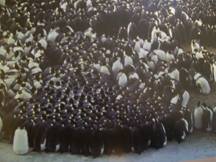
The eggs hatch after about one or two months. Tiny, down covered chicks emerge. Their soft, fluffy feathers are not waterproof, so the chicks must stay out of the ocean. They wait for their parents to bring them food. The chicks need their parents to keep them warm. They depend totally on their mother and father until waterproof feathers replace their fluffy down coats. When that finally happens, the chicks go to sea and find food on their own.
Penguins chicks are hungry from the moment they arrive in the world.
One day the little baby penguin break out of their shells and comes out. These baby penguins are called chicks. The father makes a kind of milk in his throat. He feeds his hungry chick. The chicks are covered with soft, fluffy down. Chicks stay warm on its father’s feet.
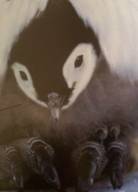
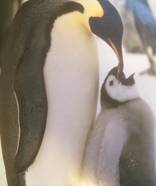
When the mother comes back to feed her new chick, the father penguin gets to go to the sea. The father has not eaten for over three months.
Soon the fathers penguin is full he goes back to his family on land. Both parents feed the penguin chick.
When the little penguin is 5 (five) months old, it will go the sea for the first time.
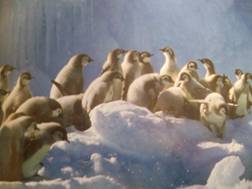
Reproduction
Interval - Breeding
The Emperor penguins breed once per year
Season - Breeding
Occurs in March and April.
Eggs in each season
One, avg. 1
Hatching time
Average of 64 days
Fledging time
Average of 150 days
Age at reproductive (female)
Average of 5 years
Age at reproductive (male) maturity
Average of 5.50 years
The Mating systems:
In March or early April the emperor penguins goes to colonial nesting areas, when the formation of a pair and breeding occurs. Towards May or in the early June a large single egg (460 – 470 g.)is laid and it is passed to the male parent penguin for incubation. The female penguin returns to the sea until the end of incubation.
In the emperor penguins colonies the egg and hatching occurring at the same time.
The incubation and brooding time occurs in the Antarctica winter –severe- frigid conditions in this planet. Protection from parents is critical.
The parental protection of the eggs and of the hatchlings is critical, because the incubation and the brood take place during the depths of the Antarctic winter in some of the most severe conditions in the planet.
The exhibition of the eggs and of the hatchlings to the coldness can lead to the quick death. The young chicks grow rapidly.
Courtship and reproduction
Reproduction:
Every year, thousands of emperor emperors go in a long journey in the centre of the frozen continent to multiply. The couples are formed, mate and, within some weeks, the female lays only one egg. She leaves it with the male and faces a journey of 80 km towards the sea, to be fed. The male penguins heat the egg with his bodies and protect it of the coldness during two months, without eating.
The babies are born and the females return, fed. They regurgitate the food to feed the small penguins, and then it is the time of the males go to the sea for food, while the mothers assume the cares for the baby penguin. While they grow, the penguins are joined in groups called "crèches". When they reach the independence, they carry out his first journey and are going for the sea to fish for its own.
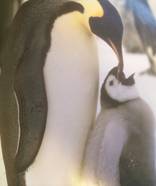
The chicks eat food that is stored in their parents’ throats. To find the food, the baby penguins stick their heads deep into their parents’ mouths.